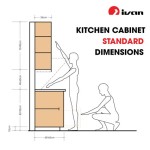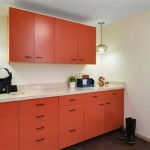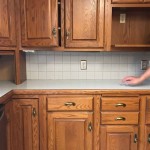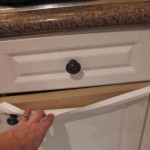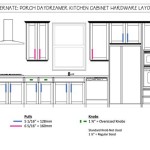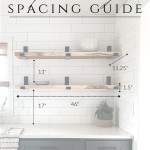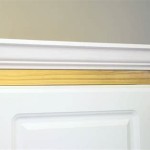How To Choose The Right Paint Color For Kitchen Cabinets
Selecting the ideal paint color for kitchen cabinets is a crucial decision affecting the overall aesthetic and functionality of the space. Kitchen cabinets represent a significant visual element, influencing the perceived size, mood, and style of the kitchen. A well-chosen color can enhance the architectural features, complement existing décor, and create a more inviting and efficient environment. Conversely, an unsuitable color selection can detract from the kitchen's appeal, making it appear dated, cramped, or uncoordinated with the rest of the home. This article will guide you through the essential considerations for selecting the appropriate paint color for your kitchen cabinets.
Considering Existing Décor and Architectural Style
Before selecting a paint color, critically assess the existing elements within the kitchen and the overall architectural style of the home. These factors play a crucial role in guiding your color choices and ensuring a harmonious and cohesive design.
Evaluate the color palette of existing elements such as countertops, flooring, backsplash, and appliances. These components should work in harmony with the cabinet color to create a balanced and visually appealing space. For example, if the countertops feature warm tones of granite or quartz, opting for cabinet colors that complement these undertones, such as warm whites, creams, or light greiges, can create a cohesive and inviting atmosphere. Conversely, if the countertops exhibit cooler tones, such as gray or black, cooler cabinet colors like white, gray, or even blue can create a more modern and sophisticated look. Carefully consider the interplay between these elements to avoid clashing colors or a disjointed appearance.
The architectural style of the home should also influence the paint color selection. In a traditional home, classic colors like white, cream, or light gray are often preferred, as they align with the timeless elegance and charm of the style. These colors can be paired with traditional hardware and decorative elements to enhance the overall aesthetic. In a modern or contemporary home, bolder color choices, such as darker grays, blues, or even black, can be used to create a sleek and sophisticated look. These colors can be complemented by minimalist hardware and clean lines to create a modern and contemporary feel. Farmhouse-style kitchens often benefit from the use of muted colors, such as sage green, pale blue, or creamy white, which evoke a sense of warmth and rustic charm. The paint color should complement the overall style and existing elements of the home.
Natural and artificial lighting significantly impacts how a paint color appears in the kitchen. Natural light can enhance the vibrancy of colors, while artificial light can alter their undertones. Test paint samples in the kitchen under varying lighting conditions throughout the day to observe how the color shifts. Colors can appear significantly different in natural light versus artificial light, especially incandescent, fluorescent, and LED lighting. Consider the amount of natural light the kitchen receives. In kitchens with limited natural light, lighter colors are generally preferred to brighten the space and create a more open and airy feel. In kitchens with abundant natural light, darker colors can be used to create a more dramatic and sophisticated look without making the space feel cramped or dark. The effect of lighting on paint colors is a crucial consideration to ensure the desired outcome.
Understanding Color Psychology and Undertones
Color psychology plays a significant role in influencing the mood and atmosphere of a space. Understanding the psychological effects of different colors can help you choose a paint color that aligns with your desired emotional environment in the kitchen.
White is often associated with cleanliness, purity, and openness. It is a versatile color that can brighten up a space and create a sense of spaciousness. However, it is important to choose the right shade of white, as some whites can appear sterile or too stark. Cream is a warmer alternative to white, creating a more inviting and comfortable atmosphere. Gray is a neutral color that can evoke a sense of sophistication and tranquility. It is a versatile color that can be paired with a variety of other colors to create different effects. Blue is often associated with calmness, serenity, and stability. It can be a good choice for creating a relaxing and inviting kitchen environment, especially in coastal or farmhouse-style kitchens. Green is often associated with nature, freshness, and vitality. It can be a good choice for creating a kitchen that feels connected to the outdoors. Incorporating green can create a refreshing and vibrant atmosphere. The psychological impact of color should be carefully considered when selecting a paint color for kitchen cabinets.
Every color has an undertone, which is a subtle hint of another color that can affect how the color appears in different lighting conditions and when paired with other colors. Understanding undertones is crucial for selecting a paint color that harmonizes with existing elements in the kitchen and avoids clashing colors. Warm colors, such as reds, oranges, and yellows, can have warm undertones like yellow or orange. Cool colors, such as blues, greens, and purples, can have cool undertones like blue or green. Neutral colors, such as whites, grays, and beiges, can have either warm or cool undertones. To identify the undertone of a paint color, compare it to a pure version of the color or to a neutral white. The subtle hue that distinguishes the paint color from the pure color or the neutral white is the undertone. Choosing colors with complementary undertones can create a cohesive and harmonious color scheme. For instance, if you have warm-toned countertops, choosing a cabinet color with warm undertones will create a seamless and inviting look. Matching undertones contributes significantly to the overall aesthetic harmony of the kitchen.
Testing paint samples in the kitchen is crucial to ensure that the color appears as expected under different lighting conditions and when paired with existing elements. Paint a small sample of each color option on a piece of cardboard or directly on the cabinet door in an inconspicuous area. Observe the color throughout the day and evening to see how it changes under different lighting conditions. Compare the paint samples to the countertops, flooring, backsplash, and appliances to see how they harmonize together. Consider painting larger samples to get a more accurate representation of the color. Taking the time to test paint samples can prevent costly mistakes and ensure that the final result is exactly what you envisioned.
Exploring Different Paint Finishes and Durability
The paint finish significantly impacts the appearance and durability of the kitchen cabinets. Different finishes offer varying degrees of sheen, resistance to moisture and stains, and ease of cleaning. Selecting the appropriate finish is crucial for ensuring that the cabinets look beautiful and withstand the demands of a busy kitchen environment.
High-gloss finishes are the most reflective and durable, offering excellent resistance to moisture and stains. They are easy to clean and can brighten up a space. However, high-gloss finishes can also highlight imperfections on the cabinet surface, making them less suitable for older or uneven cabinets. Semi-gloss finishes offer a moderate level of sheen and durability, making them a good choice for kitchens that require frequent cleaning. They are less reflective than high-gloss finishes, but still offer good resistance to moisture and stains. Satin finishes offer a low level of sheen and a soft, velvety appearance. They are less reflective than semi-gloss finishes, but still offer good durability and resistance to moisture and stains. Eggshell finishes offer a very low level of sheen and a matte appearance. They are less durable than satin finishes and may require more frequent cleaning. Matte finishes have virtually no sheen and offer a very flat, non-reflective appearance. They are the least durable of all the finishes and are not recommended for kitchen cabinets, as they are prone to staining and difficult to clean. The selection of appropriate finish is crucial for both aesthetics and practicality.
The kitchen is a high-traffic area that is exposed to moisture, grease, and other spills. Therefore, it is important to select paints that are specifically formulated for kitchen cabinets and offer excellent durability and resistance to moisture, stains, and scratches. Paints formulated for kitchen cabinets should be able to withstand frequent cleaning without fading or chipping. Look for paints that are labeled as "kitchen and bath" or "cabinet and trim" paints. These paints are typically formulated with a higher level of resins and additives that provide enhanced durability and resistance to moisture and stains. Consider using a primer before painting the cabinets. A primer will help to seal the surface, improve adhesion, and prevent stains from bleeding through the paint. Choose a primer that is compatible with the paint finish you have selected. A durable and easy-to-clean paint ensures the longevity and aesthetic appeal of kitchen cabinets.
Proper preparation is essential for achieving a professional-looking paint finish on kitchen cabinets. Before painting, thoroughly clean the cabinets to remove any grease, dirt, or grime. Use a degreasing cleaner and warm water to scrub the cabinets. Rinse the cabinets with clean water and allow them to dry completely. Remove all hardware, such as knobs, pulls, and hinges. Fill any holes or imperfections with wood filler and sand smooth. Sand the cabinets lightly to create a slightly roughened surface for the paint to adhere to. Apply a coat of primer and allow it to dry completely. Apply two coats of paint, allowing each coat to dry completely before applying the next. Reinstall the hardware after the paint has dried completely. Taking the time to properly prepare the cabinets will result in a smoother, more durable, and professional-looking paint finish.

How To Choose A Kitchen Cabinet Color According Designers

How To Choose The Right Paint Color For Your Kitchen Paintzen

How To Choose Kitchen Cabinet Paint Colors

How To Choose A Kitchen Cabinet Color According Designers

Choosing The Right Paint Color For Your Kitchen Cabinets N Hance Of Northern New Jersey

How To Choose The Right Kitchen Cabinet Colors Painting

70 Top Kitchen Paint Colors Best 2024

How To Choose Kitchen Cabinet Paint Colors

The Best Paint Colors For A Kitchen With Dark Cabinets

Choosing The Right Paint Color For Kitchen Cabinets
Related Posts

